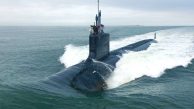
Adapting U.S. Airpower to Counter China’s Missile Threat
The Washington Post
WASHINGTON: The United States and its allies must overhaul their air forces to counter China’s vast missile capabilities, which could disable air bases across the Indo-Pacific for up to 12 days in the event of war, according to a new report from the Stimson Centre.
“By denying the United States the use of runways and taxiways in the region, the People’s Liberation Army (PLA) could gain air superiority without ever engaging America’s advanced fighters and bombers,” the report states. Released today, it highlights the growing risk that Beijing may believe it could neutralize U.S. airpower long enough to achieve a swift and decisive victory.
The report focuses on U.S. vulnerability to missile attacks on airfields in Japan, Guam, the Northern Mariana Islands, the Marshall Islands, the Federated States of Micronesia, and Palau. The analysis includes simulations of missile defence systems, rapid runway repair efforts, and the strategic dispersion of aircraft, concluding that none of these measures alone can adequately counter the Chinese threat.
Key findings suggest that initial PLA strikes could cripple air bases for 12 days, particularly those in Japan. Even more concerning, the loss of runways critical for airborne tankers could disrupt operations for over a month, leaving U.S. short-range fighters unable to reach key areas like Taiwan or the South China Sea.
The report emphasizes that these challenges place a significant burden on the U.S. Air Force to develop solutions. “The Air Force risks operating far less effectively, if at all, during the critical opening days of a conflict, when it would need to establish air dominance or strike Chinese targets,” the authors warn. Chinese planners might exploit this vulnerability, believing they have a month-long window to execute military objectives.
The solution, according to the authors, does not lie in acquiring more traditional systems like missile defences, fighters, or bombers. Instead, they recommend investing heavily in long-range drones and missiles to contest Chinese air superiority and blunt attacks early in a conflict, even without full support from traditional airpower.
The report underscores the insufficiency of current missile defence systems. In a recent real-world scenario, two U.S. Navy ships used a year’s production of SM-3 interceptors in a single day to defend against Iranian missiles. Similarly, the U.S. inventory of Patriot and THAAD interceptors could be exhausted within 24 hours of conflict, leaving air bases vulnerable.
Allies and partners must also share the burden, the report advises. Rather than investing in high-profile weapons like Japan’s upgraded F-16s or its co-developed sixth-generation fighter jet, allies should prioritize expanding drone warfare capabilities and training.
The authors conclude with a sobering reminder: U.S. air bases in the Indo-Pacific will have no safe haven from China’s missile reach. Policymakers must confront whether the costs in lives and resources align with U.S. national interests in such a conflict.



